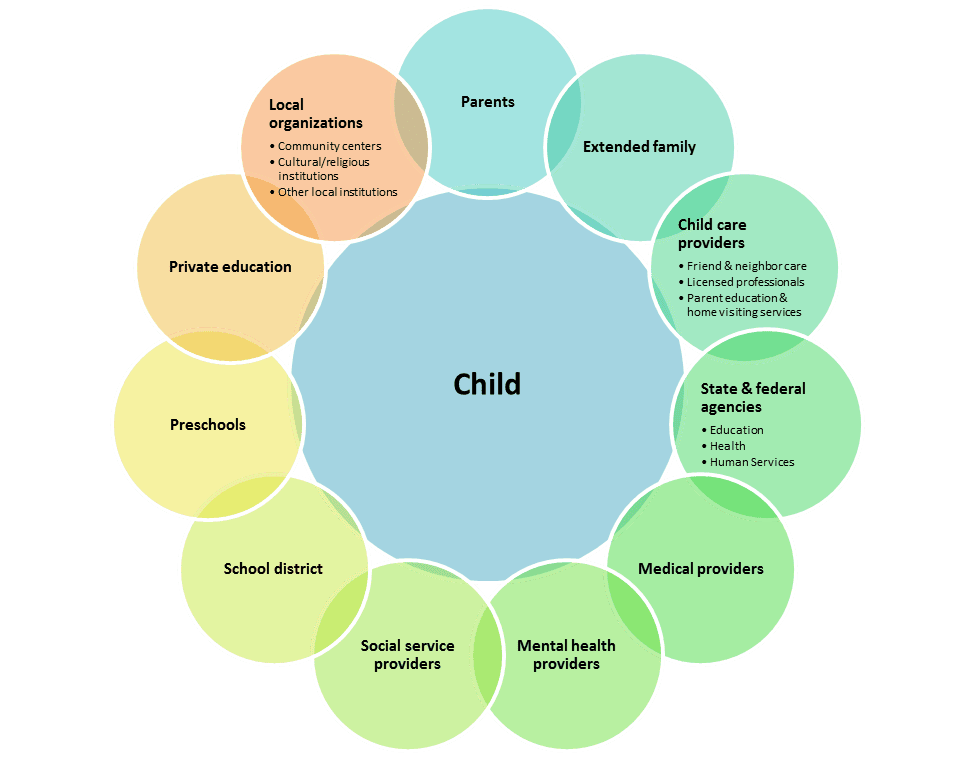In my previous post, I introduced you to Daphne, a two year old whose experiences at home are risking her healthy development. While there are numerous societal supports for children like Daphne, the lack of coordination between these piecemeal services can lead to major gaps in services. I described this as a case of the Swiss cheese dilemma, in which the vulnerabilities of each support system align like the holes in multiple slices of Swiss cheese, creating an even more gaping hole (if you will let me extend the metaphor) in Daphne’s social safety net. The result: Daphne grows up with insufficient adult interaction, poor healthcare, and delayed cognitive development.
It is no easy task bringing together the various stakeholders working in the early childhood space. Not only are there so many of them, but each set of stakeholders has different priorities and objectives – access to childcare, proper nutrition, literacy targets, etc. In order to enable better communication and collaboration in the 0-8 early learning field, last year FSG published Markers that Matter, a report that synthesized 1,100 existing indicators into a set of 48 early childhood indicators.
Emerging Collaborations in Early Childhood Development
Despite all these challenges, some organizations and communities have begun to take a more collaborative approach to supporting early childhood. Some of these are locally-based collective impact efforts, others are broader movement-building initiatives. Each of these efforts is a work in progress, with everyone learning their way into best practices. In each case, organizations are innovating to avoid the Swiss cheese dilemma by connecting the many systems working to improve early childhood outcomes.
- The Alberta Family Wellness Initiative works to mobilize knowledge about brain development as it relates to early childhood development and its lifelong impact on addiction and other health outcomes throughout the province of Alberta. Underscoring the initiative’s theory of change is the notion that by connecting the science, policy, and practice communities, a shared vocabulary and understanding of the “brain story” will catalyze best practice dissemination and innovative collaborations that promote family wellness.
- The Center for Disease Control’s Essentials For Childhood program is funding five state health departments in California, Colorado, Massachusetts, North Carolina, and Washington to use a collective impact approach to coordinate cross-sector strategies, develop data-driven initiatives, and create an enabling context for improving childhood outcomes. In Washington state, the effort is being co-led by the state departments of health and early learning, which presents both a challenge and an opportunity to truly collaborate across typically isolated sectors.
- Providence Talks is a municipality-led initiative funded by Bloomberg Philanthropies to help the Rhode Island city’s poorest residents increase the quantity and complexity of conversation with their young children. The program is partnering with existing home visitation and center-based service providers to gather “word pedometer” data and provide targeted coaching and additional resources to these families.
- In Southwest Ohio and Northern Kentucky, United Way-housed backbone organization Success By 6 engages parents, community leaders, local businesses, and government to raise awareness about the importance of the early years and to make early learning a top policy and funding priority. In addition, the backbone works with school districts, home visitation programs, preschools, and daycares to coordinate services, including facilitating alignment of daycare and home visitation priorities with school readiness standards.
- Launched in 2013 by former Secretary of State Hillary Clinton and nonprofit Next Generation, Too Small To Fail intends to promote scientific research, convene stakeholders, and launch campaigns in partnership with the media and entertainment industries to target the broad public and businesses in order to improve the health and well-being of children ages zero to five. One of the first initiatives includes a publicity campaign, being piloted in Tulsa with bus stop signs, billboards, doctors, church ministers, and the like, with the simple message that “talking is teaching”.
These examples are just a few of many. Please share with us the ways that you have seen organizations effectively come together around early childhood development.

